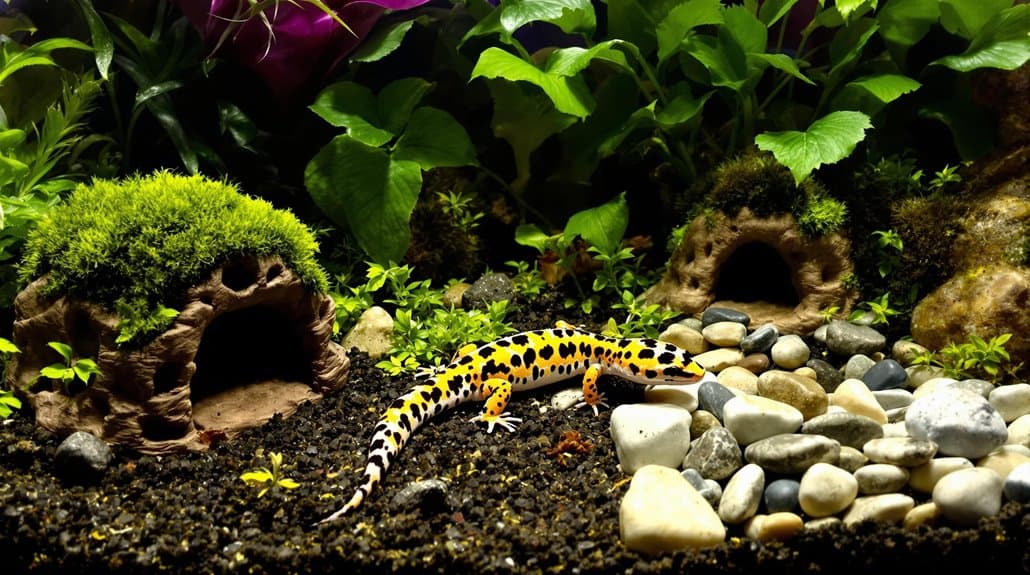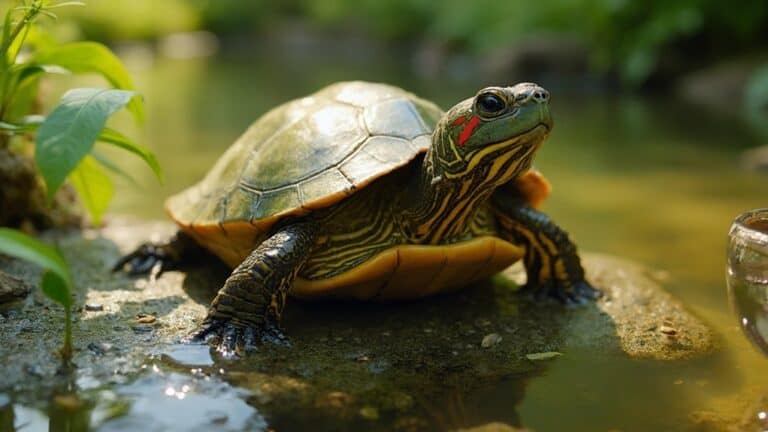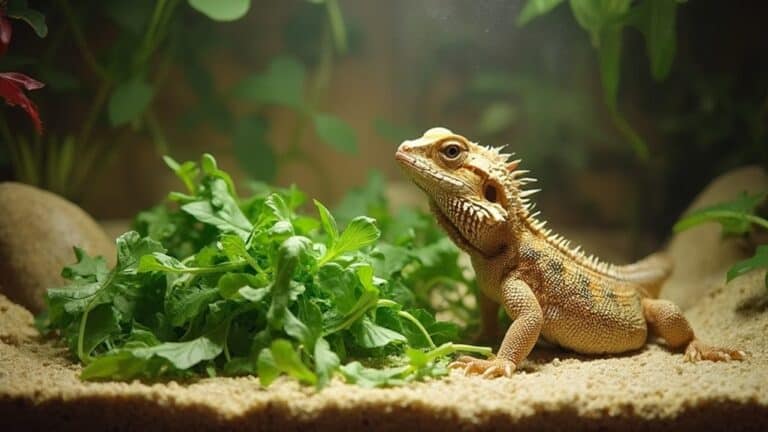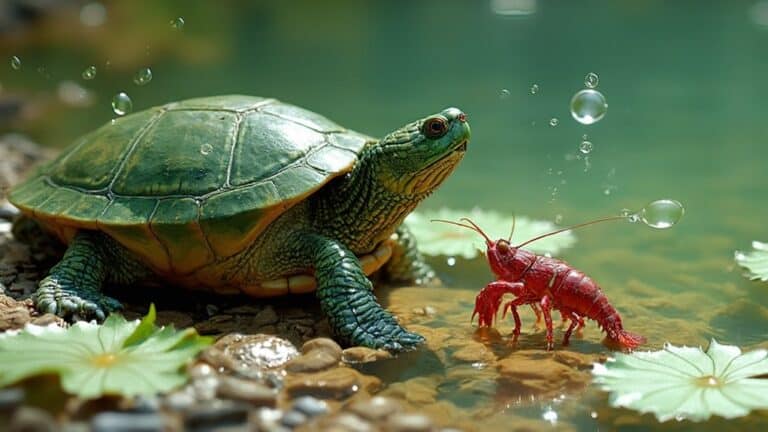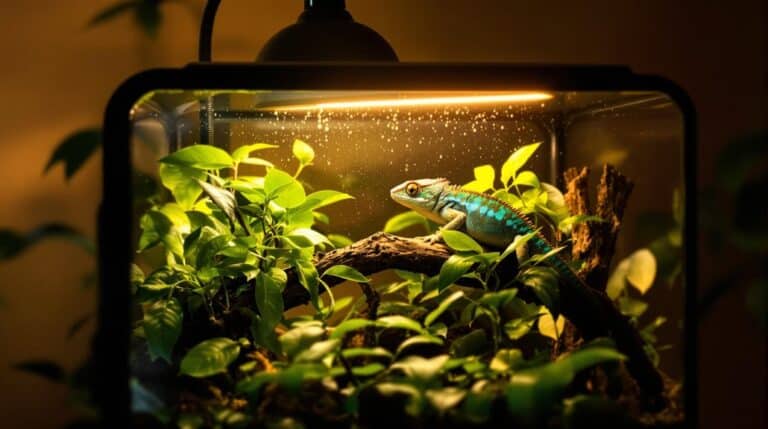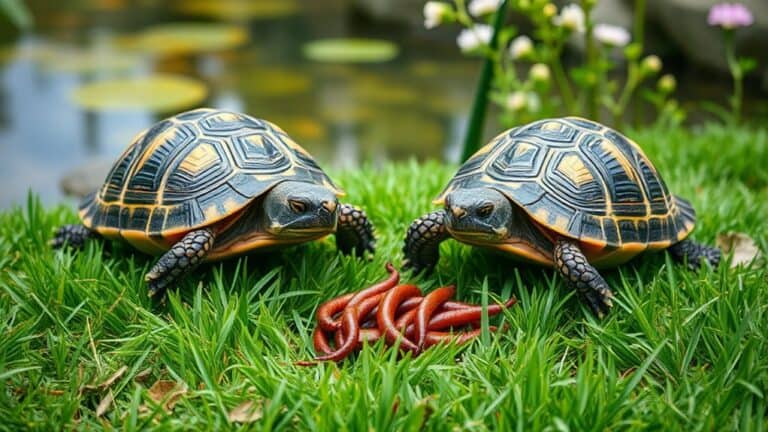Leopard Gecko Bioactive Setup
Setting up a leopard gecko bioactive setup is like turning your living room into a mini jungle! First, grab a sturdy enclosure that’s at least 36×18 inches—think of it as their spacious apartment! For substrate, mix organic topsoil, sand, and some clay for comfy burrowing. Add cool plants like aloe, but remember, they must play nice with cleanup crew buddies like springtails and isopods! Light it up with UVB bulbs for health, and keep basking spots sunny and warm. It’s a lively ecosystem, so you’ll need to watch over their little world closely. Stick around, and I’ll share more tips!
Table of Contents
Key Takeaways
- Select a spacious enclosure (at least 36x18x18 inches) with proper ventilation, temperature gradients, and natural aesthetics for your leopard gecko.
- Use a safe substrate mix of 40% organic topsoil, 40% sand, and 20% Excavator Clay, ensuring a depth of 3-4 inches for burrowing.
- Incorporate a clean-up crew with springtails, isopods, and beneficial microbes to maintain waste breakdown and ecosystem health.
- Choose drought-tolerant plants like aloe and haworthia, creating microclimates while ensuring compatibility with the clean-up crew.
- Provide essential UVB lighting and maintain basking temperatures between 94-97°F, while ensuring a cool zone of 70-77°F for optimal health.
Enclosure Selection and Design

When selecting an enclosure for a leopard gecko bioactive setup, what should you keep in mind? First, size matters! You’ll want at least 36x18x18 inches to give your gecko room to roam, bask, and dig. Think of it like a cozy apartment where your little buddy can feel free and happy!
Now, let’s talk materials. Durable, moisture-resistant materials like glass or high-quality acrylic work wonders. They’re like superhero shields against leaks! And don’t forget about ventilation techniques; a large front ventilation system is key. It’s like giving your gecko fresh air to breathe, just like we enjoy a breeze on a sunny day. Additionally, ensure that the enclosure allows for proper temperature and humidity gradients, which are essential for your gecko’s well-being. Providing a bioactive environment can also enhance environmental enrichment for your gecko, ensuring it displays natural behaviors.
Next up, enclosure aesthetics! Choose designs that are visually appealing and natural-looking. Adding rocks and wooden hides can make your setup feel like a mini jungle. Plus, sealing all internal joins with silicone is a must! It’s like wrapping your enclosure in a snug blanket, keeping moisture at bay.
Substrate Selection and Preparation
Selecting the right substrate for your leopard gecko bioactive setup is essential for creating a healthy environment. It’s like picking the perfect bed for your little buddy! I recommend a mix of 40% organic topsoil, 40% sand, and 20% Excavator Clay. This combo not only looks great but also helps with moisture retention. Your gecko will love it! Additionally, incorporating natural hiding places will provide your gecko with security and help reduce stress.
When choosing substrate types, avoid anything dangerous like linoleum or aspen shavings. Trust me, those are a no-go! Instead, use pre-washed, silica-free play sand or fine-grain dune sand to keep your gecko safe and sound. Make sure to pack the substrate down to about 3-4 inches deep; this gives your gecko room to burrow and manage humidity just right. A clean-up crew of beneficial insects can also thrive in this substrate, maintaining a healthy ecosystem.
Don’t forget to mix in some leaf litter or palm prawns to create a fun, natural vibe! And hey, while you’re at it, add plants like succulents that fit the desert theme. They’ll add beauty and help with air quality. Keep an eye on humidity levels, and your gecko will thrive in its little paradise. Happy substrate hunting!
Clean-Up Crew and Beneficial Organisms

Now that you’ve set up the perfect substrate for your leopard gecko, it’s time to think about the clean-up crew and beneficial organisms that will help maintain a thriving bioactive ecosystem. These little heroes work hard behind the scenes! First up, we have springtails. They’re like tiny janitors, breaking down organic matter and recycling nutrients. Then, there’s isopods, which include dwarf white and pill bugs. They help decompose waste, keeping things tidy and fresh!
But wait, there’s more! Lesser mealworms and their beetles also contribute to waste breakdown—think of them as the backup dancers in this cleanup crew! Don’t forget about the essential microbe populations, like beneficial bacteria and fungi; they’re the unsung champions of organic matter decomposition. Self-sustaining ecosystems are a key advantage of incorporating these organisms, as they enhance the overall health of your vivarium.
To kick off your crew, use compost starters like Bene-Bac. Make sure to introduce everything gradually, so you don’t overwhelm your ecosystem. Monitor conditions like temperature and humidity to keep your crew happy. With a diverse cast of characters, you’ll achieve a balanced ecosystem that thrives. The clean-up crew benefits everyone, turning your leopard gecko’s home into a lively, healthy paradise!
Plant Selection and Placement
Creating a vibrant bioactive setup for your leopard gecko involves careful plant selection and strategic placement. It’s like throwing a party for your little scaly friend! First up, let’s choose some arid plants that love dry conditions. Think aloe, haworthia, and snake plants—these guys are drought-tolerant and won’t mind the low humidity. Just remember, no spiny plants! We want to keep those little toes safe and sound.
Next, think about microclimate creation. You can use plants to craft cozy, humid hideouts under rocks or logs. Layering different plants adds variety and makes the habitat super interesting! I like to mix in some grasses or ground covers, like Carex, to really spice things up. Additionally, it’s essential to maintain ambient humidity levels between 30-40% to ensure your gecko’s comfort and health.
When placing your plants, dig deep so your gecko can burrow and explore. Balance is key, don’t overcrowd! Let your gecko roam freely while still having plenty of hiding spots. And hey, make sure your plants are bioactive compatible. They need to live happily with isopods and springtails. With a little love and planning, you’ll create a fantastic jungle for your leopard gecko!
Lighting and Temperature

Lighting and temperature are essential elements in crafting a healthy environment for your leopard gecko. Think of it as setting the stage for a grand performance! The right lighting and warmth help your little buddy thrive and feel fabulous.
Here’s what you need to keep in mind:
- UVB benefits are a game-changer for their health.
- A basking spot should sizzle at 94-97°F for maximum energy.
- Create cozy cool zones between 70-77°F for those chill moments.
- Replace UVB bulbs every 12 months—trust me, it’s worth it!
- Remember to turn off the lights at night to mimic nature.
Choosing high-quality UVB bulbs, like the Arcadia ShadeDweller, can work wonders for vitamin D production and immune support. Additionally, using high-quality fluorescent lights ensures that your gecko receives the necessary UVB exposure without excessive heat. Plus, don’t forget that temperature regulation is key! Your gecko craves a warm hide around 90-92°F to feel cozy. Ensuring the right light intensity is also crucial for the health of both plants and reptiles in your bioactive setup.
Maintenance and Monitoring
Maintaining a thriving bioactive setup for your leopard gecko requires consistent attention and monitoring. Think of it as caring for a tiny jungle! Each day, I spot clean by removing any leftover food, feces, or shed skin. A light misting helps keep things hydrated, which is super important for shedding. I’m always checking the humidity, aiming for around 25% and making sure that humid hide is cozy between 65% and 85%. Providing a suitable temperature gradient is essential for my gecko’s health and well-being, as it helps prevent shedding issues and supports their overall well-being.
I keep track of my feeding schedule too, ensuring both my gecko and custodians are munching on the right goodies! To make it easier, here’s a quick reference table:
| Daily Tasks | Weekly/Monthly Tasks |
|---|---|
| Spot cleaning | Inspect bioactive ecosystem |
| Misting | Feed custodians |
| Humidity checks | Replace leaf litter |
| Temperature checks | Water plants |
Long-term, I monitor my gecko’s health and overall environment stability. By keeping everything balanced, I know my little buddy is happy and thriving! So, grab your tools, and let’s keep this mini-ecosystem in tip-top shape!
Additional Tips for Success

To guarantee success with your leopard gecko’s bioactive setup, I often recommend paying attention to the little details. These tiny tweaks can make a big difference in your gecko’s happiness and health. It’s all about understanding gecko behavior and getting moisture management just right!
Here are some tips to elevate your setup:
- Mix it up: Combine organic soil, sand, and clay for a natural feel.
- Happy helpers: Introduce isopods and springtails to keep things clean and fresh. Regularly monitor clean-up crew health to ensure they are thriving in the environment.
- Plant power: Choose non-toxic plants that thrive in the desert, like succulents.
- Hiding places: Give your gecko plenty of nooks and crannies with rocks, logs, and more.
- Moisture magic: Add humidity hides with moss for a cozy retreat during shedding.
Conclusion
Setting up a bioactive habitat for your leopard gecko is like throwing a wild party for your little buddy! With the right plants, critters, and cozy spots, you’ll create a lively ecosystem that keeps him happy and healthy. Just remember, a little maintenance goes a long way, like cleaning up after a party! So roll up your sleeves, immerse yourself, and watch your gecko thrive in its very own jungle. Happy herping!

